1lumen selects and reviews products personally. We may earn affiliate commissions through our links, which help support our testing.
Nitecore TINI2 – SS and Ti review
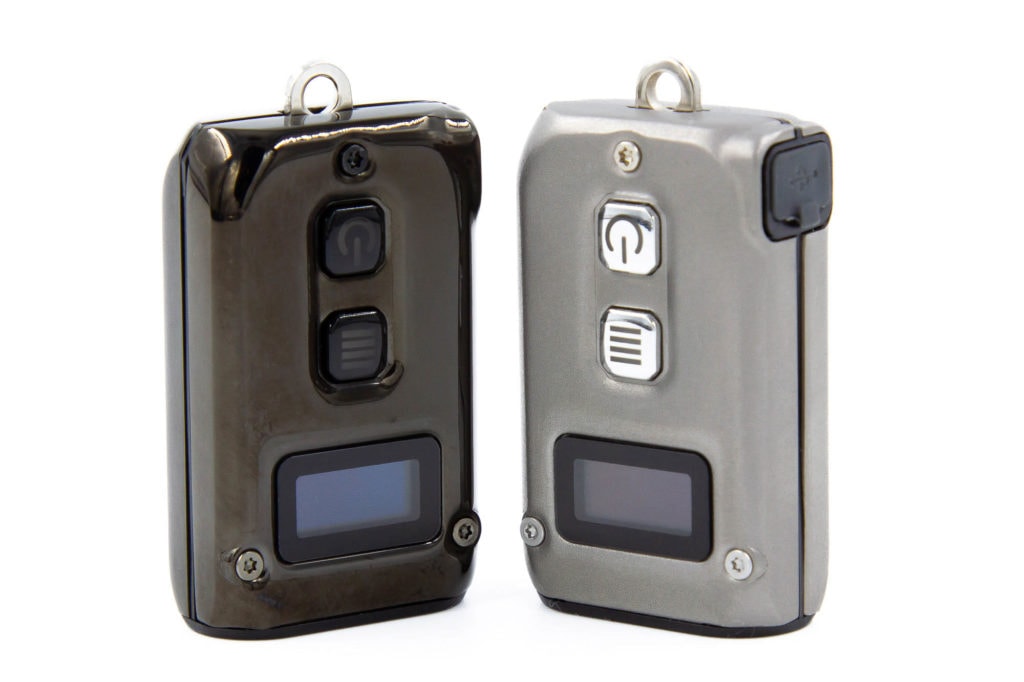
Nitecore TINI2 Titanium & Stainless Steel specifications
| Brand/model | Nitecore TINI 2 SS / Nitecore TINI 2 Ti |
|---|---|
| Category | Small flashlights, pocket flashlight, EDC flashlight, keychain flashlight |
| LED | 2* OSRAM P8 |
| Max. Lumens | 500 lm |
| Max. Beam intensity / distance | 2000 cd (89.44m) |
| Battery config. | Internal Li-Ion 280mAh |
| Onboard charging | USB-C |
| Modes | 5 |
| Blinkies | N/A |
| Reflector | Custom TIR |
| Waterproof | IP54 |
| Review date | March 2022 |
Introduction:
Nitecore have sent to me the latest release of the TINI2 that I previously reviewed – this time, the outer casing is made of, depending on the model you choose, either titanium or PVD coated stainless steel in a lovely shiny black.
The images speak for themselves, but this is an adorably small keychain light that can still pack a punch.
Given the specs are, on paper, the same as the TINI2, this is more an evolution than a revolution, but still a welcome one. Options of finish are always appreciated, and these are some very attractive options. As a result, the review is probably going to be very similar, if not a direct replica in parts of the TINI2 review, so please bear with me – re-phrasing things doesn’t serve much purpose, and that leaves more time for lovely photos.
Onwards!
Package quality.
The parcel from Nitecore didn’t include the retail boxes; I received the lights in separate bubble-wrap with just the clip as an addition, but that’s fine – I’ll revisit the retail package of the TINI2, which Nitecore’s site shows is almost identical for the special editions.
Inside the box will be:
- The Nitecore TINI2 (of the particular variety you choose)
- Keyring attachment tucked slightly underneath
- Manual
- Warranty card
As mentioned previously, the only thing to bemoan is the lack of charging cable.
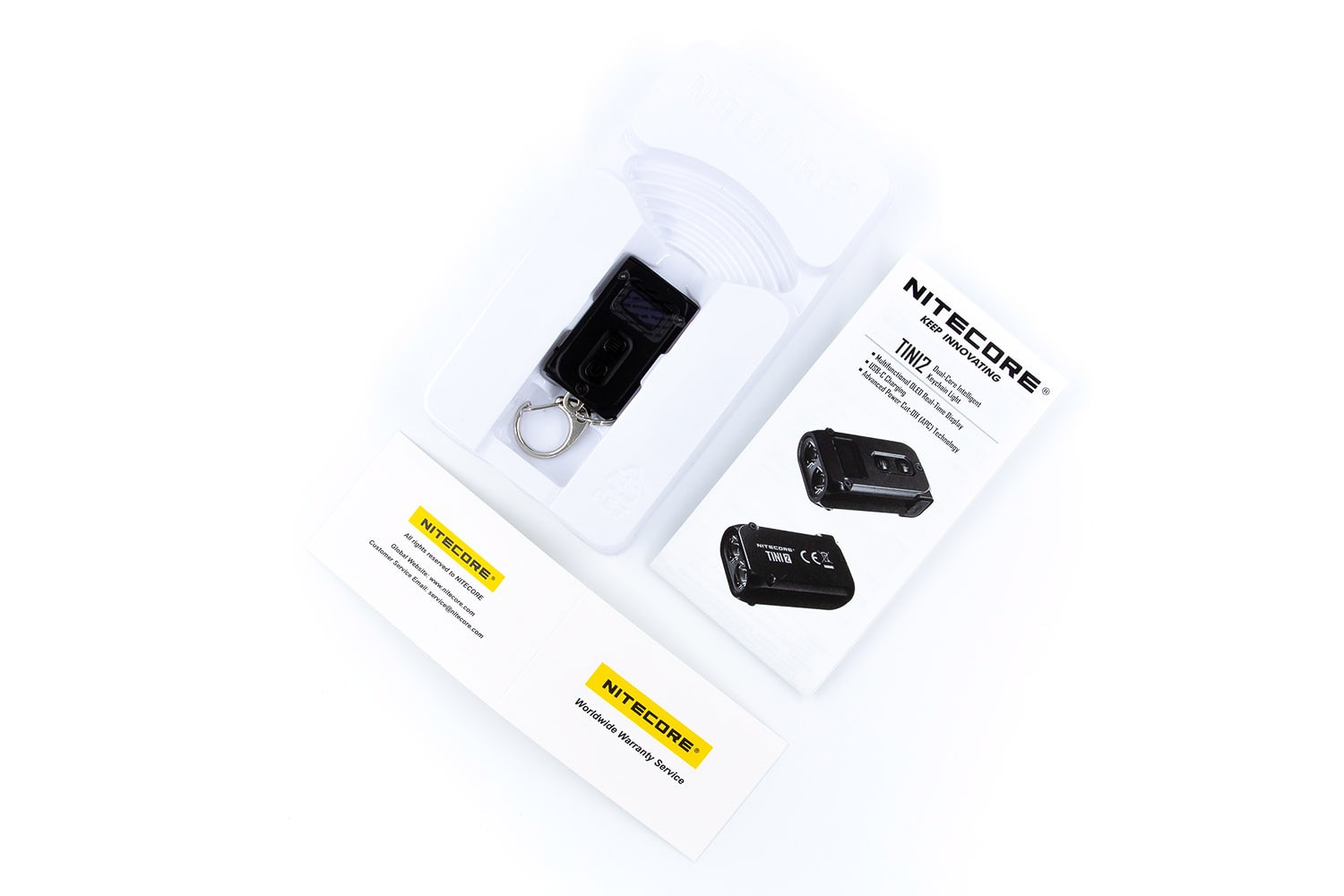
Image is taken from Tini2 review
Flashlight in use
If you haven’t already noticed by now – this is quite a small light. At only 4.2 cm on its longest edge, the top section of my thumb almost completely covers the light, so using it is a little bit of a “pinch and press” motion.
The buttons have a good feel to them, so you don’t end up wondering whether you clicked or not. They’re also not so hard that you need to put considerable effort in either. They light up blue when charging and at low battery, but otherwise stay dark.
Nitecore has this pegged as a keychain light, and it definitely fits the bill for that – unless your keyring only has one or two keys on it, the extra weight this adds is fairly negligible.
The lockout modes on this are definitely useful for when on a keyring and shoved into a pocket, though. With that said, I have spent a few days with this in my pocket with my keys unlocked as a test, and I haven’t had any activations that I’m aware of. Assuming a quick press, the highest mode is 200 lumens, and I can hold the TIR against my skin at 200 lumens for quite some time and not feel any real heat from it. If you managed to press down the mode button and hold turbo for some time, that might be a different story…
Tail standing: Nope, the keyring loop is in the way.
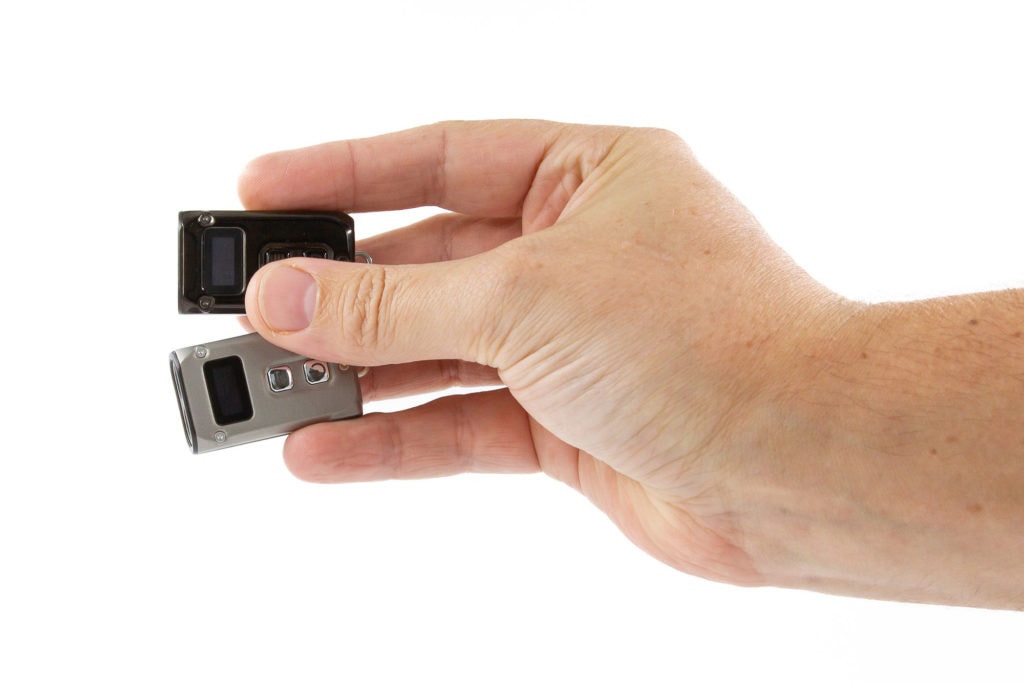
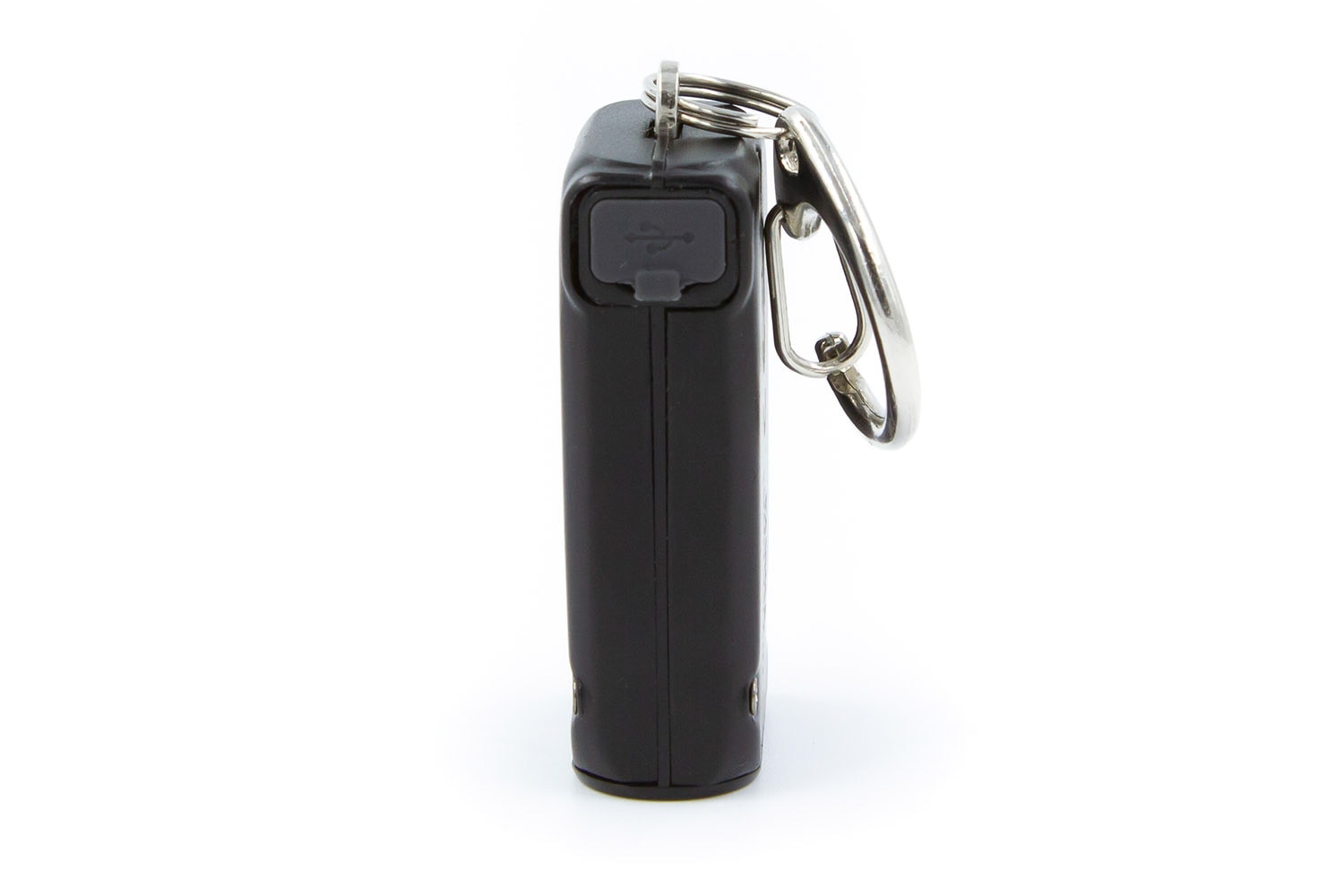
Build Quality, and Warranty
The TINI2 of all varieties is built in a modular fashion, with a plastic frame as the core of the body, with thin metal casings on either side to complete the look. The finish on the metal casings is top-notch as always with Nitecore, and is a very smooth feel for the SS, and what feels like a sandwashed feel to the Ti model.
The SS model is VERY prone to fingerprints, however. That shine comes at a cost!
There’s a small loop at the bottom of the light to attach the keyring loop to, which is attached to the frame via a screw, so if the loop were to be damaged, it could be removed and replaced. Again, a great move for repairability.
The snap-ring included with the light is quite small and strong, which is great for its intended purpose, but I had a fair bit of trouble getting it attached due to the size of my thumbs. Coming back to it later though, it wasn’t too difficult to remove and put back on, so familiarity with the mechanism is key.
The small flap covering the USB-C port is quite solid, and has only a small protruding tab. When brushing my finger across it multiple times, the cap barely moved, but when sliding a fingernail past it quickly, it popped outwards, ready for rotation to expose the port. I’m fairly satisfied that this will remain secure over time, though.
Nitecore’s warranty covers DOA or defective products within 15 days direct to the dealer, and then covers repairs for 2 years, due to the inbuilt battery (lights without inbuilt batteries come with 5 years warranty).
After this, Nitecore will cover labour costs and maintenance for repairs, with the cost of components being charged.
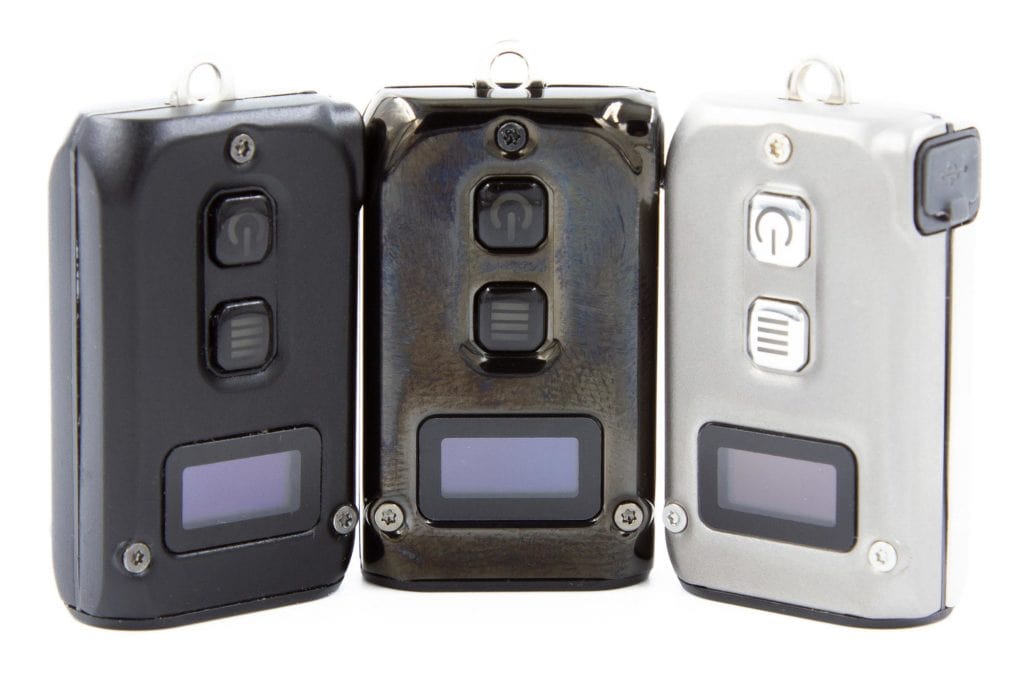
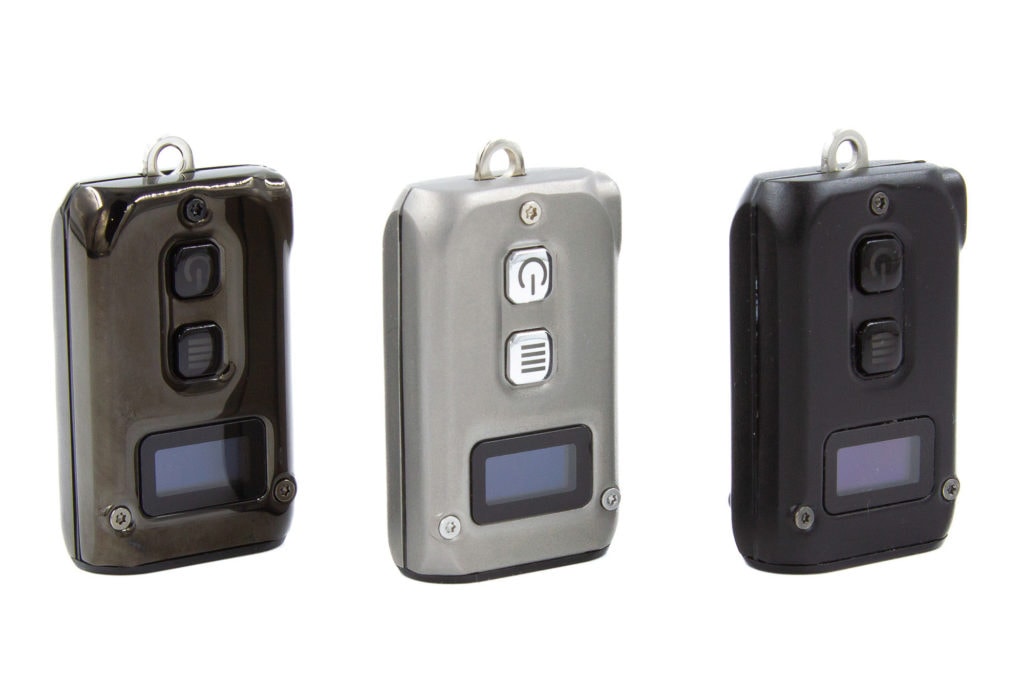
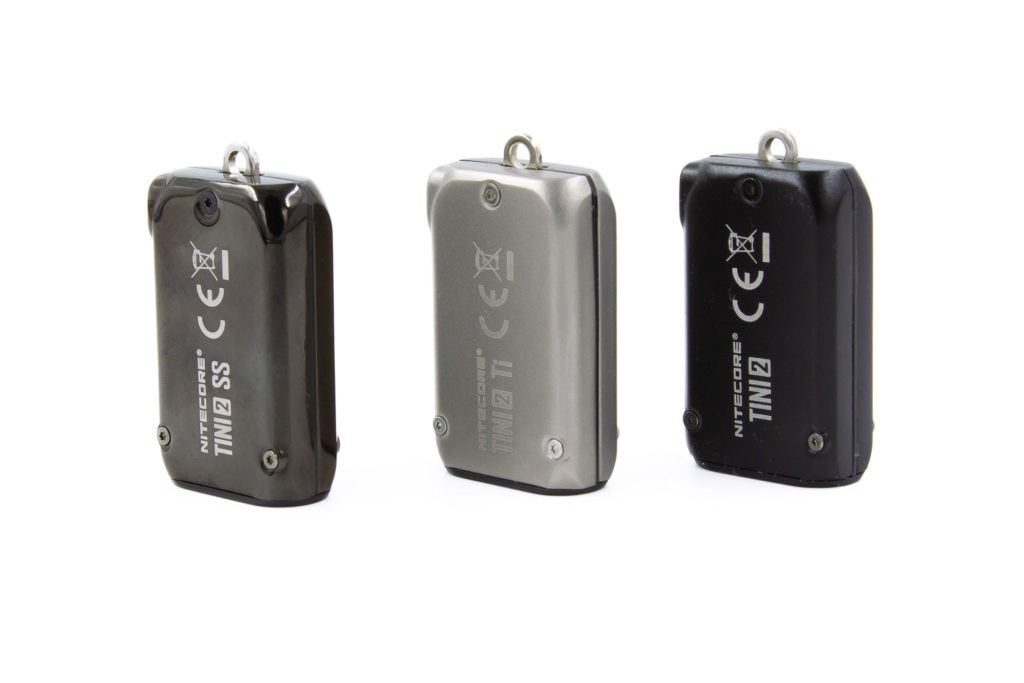

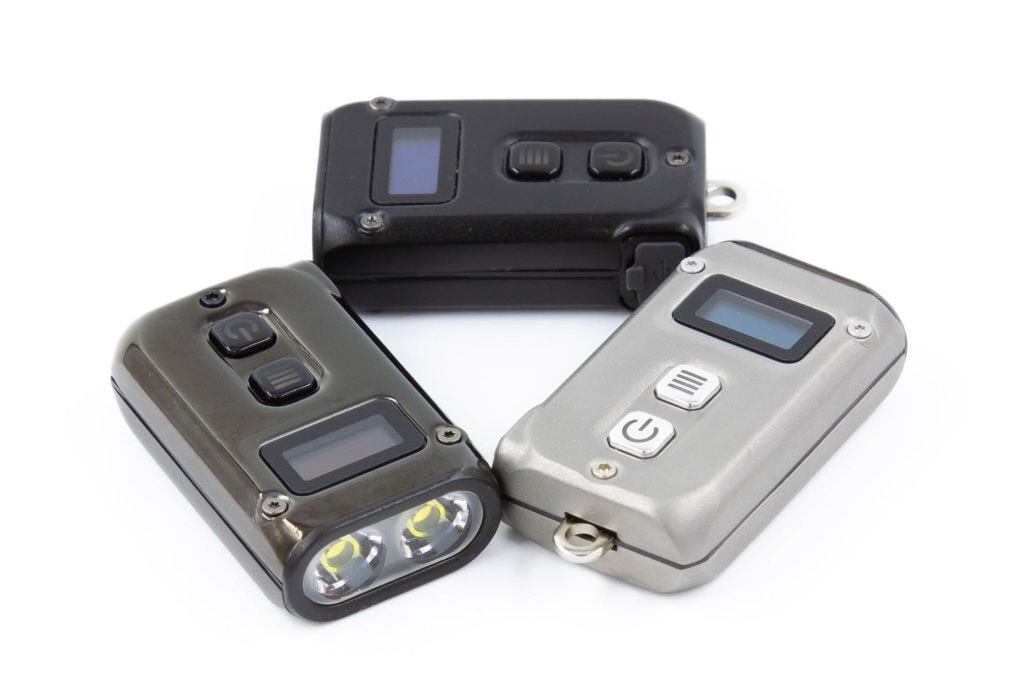
LED, Lens, Bezel, Beam, and Reflector
Tucked neatly behind a custom TIR, the TINI2 has two Osram P8 emitters, otherwise known as the PUSRA1.PM. While the CCT of them isn’t mentioned, and I previously noted that they looked around 5700K to me, I now have my Colormunki, so behold – spectrographs!
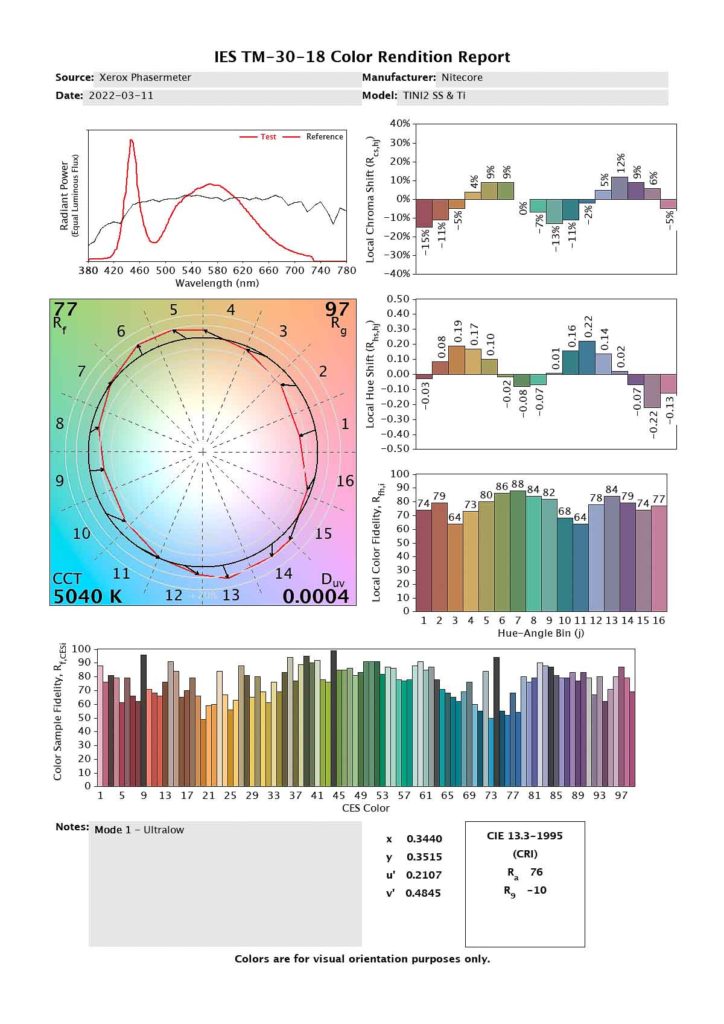
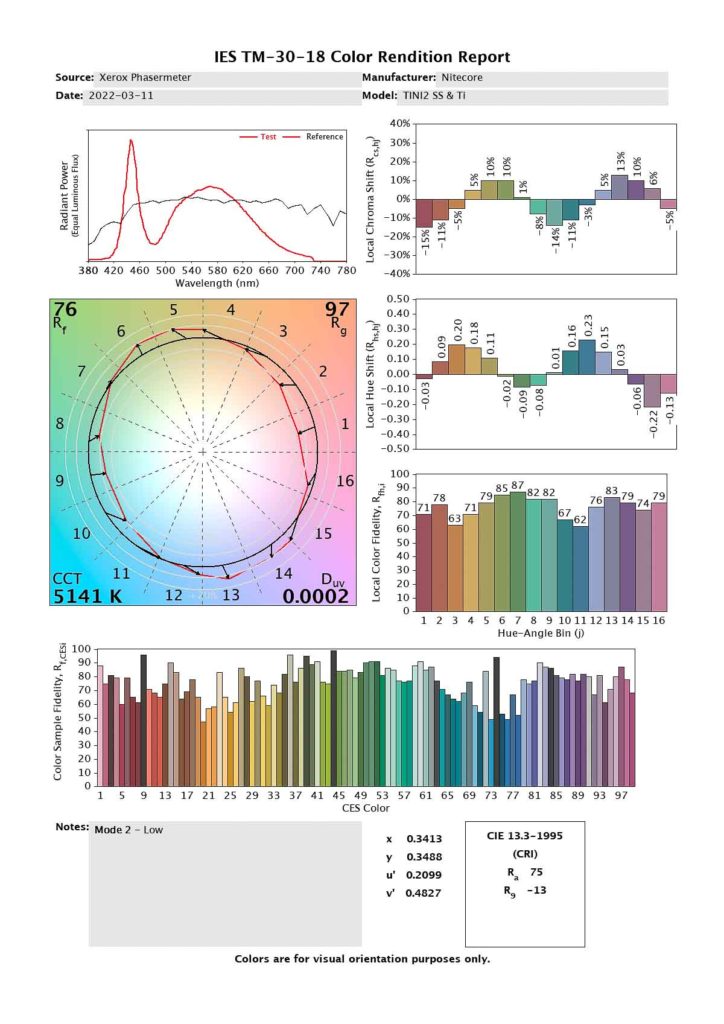
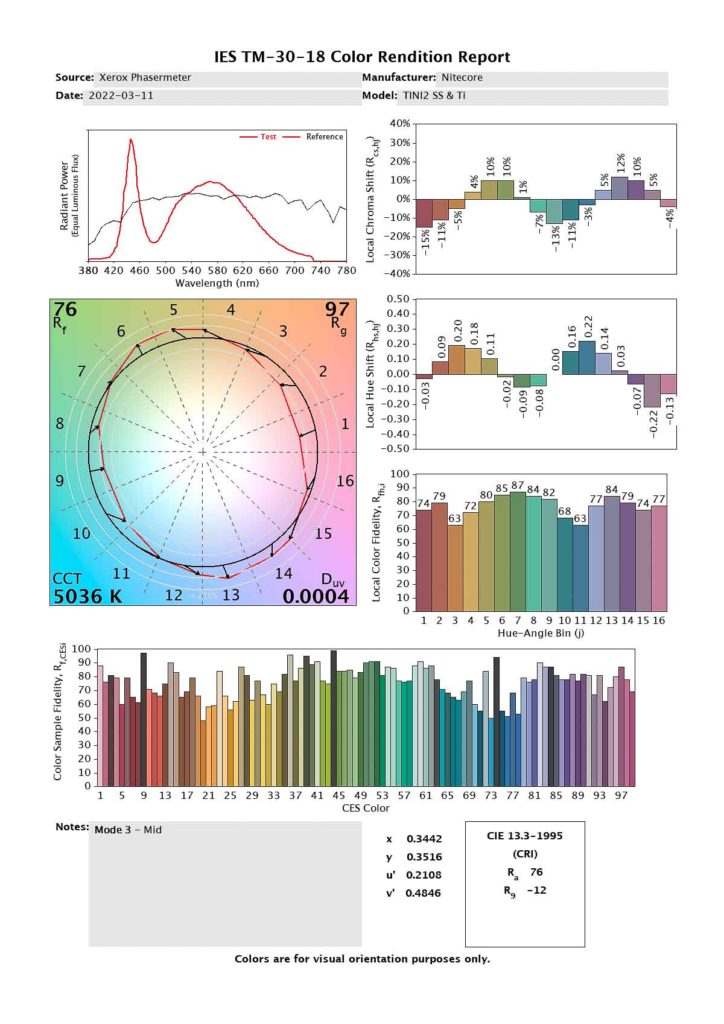
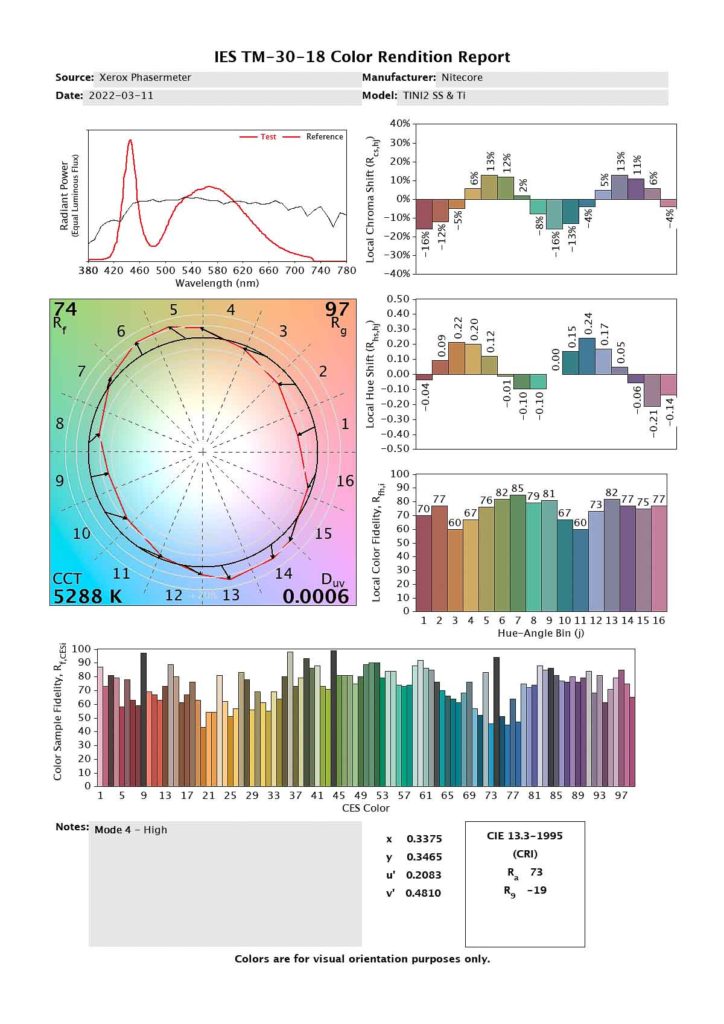
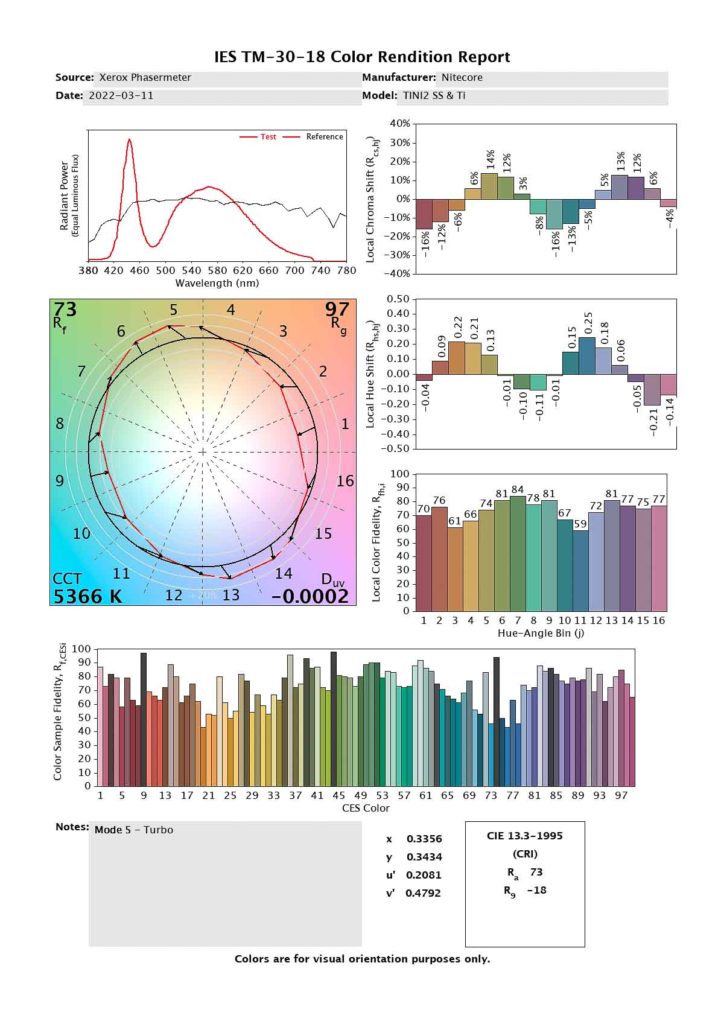
It’s not very surprising, but the emitters are geared more for output than colour fidelity. CCT is somewhere between 5000 and 5300K, duv hovers slightly positive except for in Turbo, and the CRI is.. Well, it’s a number, anyway. R9 values in the negative are expected at this point.
Despite being in a side-by-side configuration, the beam doesn’t appear to be elongated or stretched at all. Unless I turn the light on right against a wall, the hotspot is very circular, but looking at the TIR I can’t see any evidence of them being angled towards each other. Impressive!
There’s no glass above the TIR, so while the TIR is quite tough, after a while you may get scratches on it that might impair the beam – but that would be quite a scratch.
As previously mentioned, due to the modularity of this light, the emitters could be swapped quite easily. Other CCTs of the Osram P8 will go on seamlessly, but you could also swap in your favourite 3535 emitters like the Samsung LH351D, Nichia 219b, Nichia 519a, etc etc – it would just require a bit more care to centre it correctly onto the 3737 pad. I had put LH351D in the initial TINI2 I reviewed, but I think these deserve some 219b or dedomed 519a love.

Dimensions and size comparison
Length x Width x Depth: 42.3 x 25 x 12.5mm (1.83 x 0.98 x 0.49”)
Length:
- Length: 42.3 mm / 1.83 inches
- Width: 25 mm / 0.98 inches
- Depth: 12.5 mm / 0.49 inches
Weight without clip:
- Ti model: 19.2 grams / 0.68 oz
- SS model: 25.5 grams / 0.9 oz
Slightly heavier than the standard edition (15.7g/0.55oz), and the ultralight crew will probably be hyperventilating – but for everyone else, it’s almost unnoticeable.
Flashlight size comparison with its competition
Compared to the Astrolux K1 and Olight i1R2 Pro.
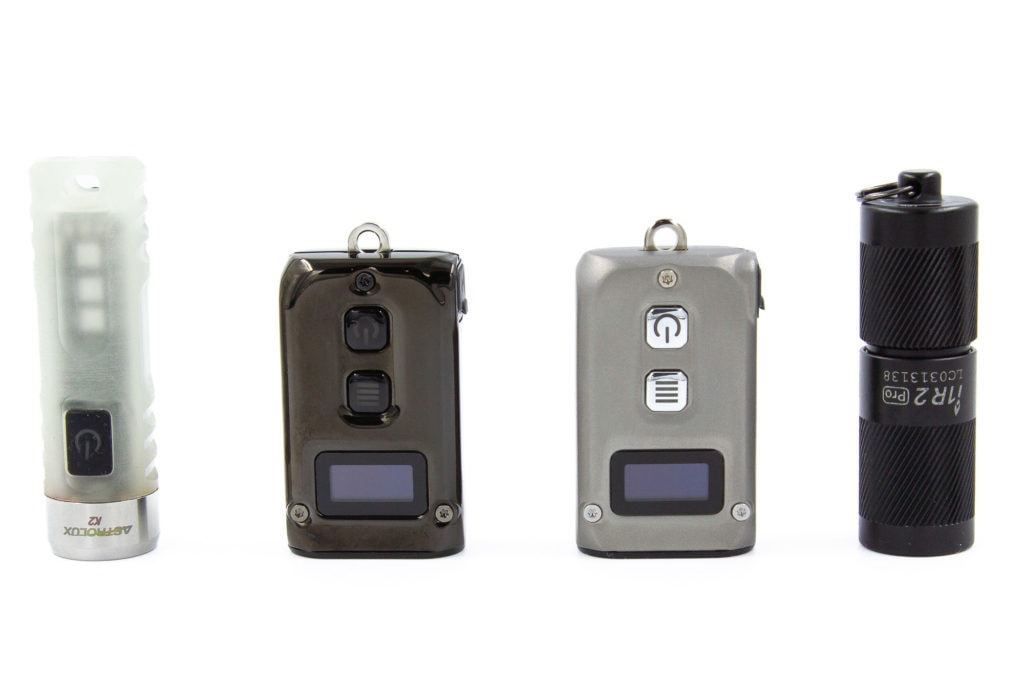
Driver & User Interface:
The TINI2 generally has 2 overarching modes – Daily mode, and Demo mode. There’s two lockout modes, and in one of them, you can still (semi) use the light.
Out of the box, the light will come into Demo mode. This mode is the same as Daily mode, but with the difference that the light will only stay on for 30 seconds after the last mode change. Turbo can still be accessed as per Daily mode, but more on that later.
To switch between Demo and Daily mode, hold both buttons on the light and the display will show the mode changing, and flash (once for Daily to Demo, and twice for Demo to Daily).
Modes:
- Ultra-Low (1 lumen)
- Low (15 lumens)
- Mid (65 lumens)
- High (200 lumens)
- Turbo (500 lumens)
From OFF:
Mode button:
- 1 click: Turns display on, showing battery life, main mode (Daily/Demo), and brightness level (marked as Lv.1 through Lv.4)
- Press and hold: Turbo (see note below)
Power button:
- 1 click: On : last used mode
- Press and hold: Ultra-low (1 lumen)
- 1 click + press and hold for 1 second: Lockout mode 1
- 1 click + press and hold for 3 seconds: Lockout mode 2
See notes below regarding lockout modes, once you’re in them.
From ON:
Mode button:
- 1 click: Cycle through modes, Ultra-low through High
- Press and hold: Turbo
Power button:
- 1 click: Off
- Press and hold for 1 second: Lockout mode 1
- Press and hold for 3 seconds: Lockout mode 2
Turbo mode note:
Running the TINI2 on Turbo doesn’t have a hard timer, and appears to just act like another mode, with runtime indicated by the OLED screen as per all other modes. You do need to keep holding the button, though.
Mode memory:
- All modes, except for Turbo.
Shortcuts:
- To Turbo: Hold the Mode button from on or off.
- To Ultra-low: Hold the Power button from off.
Low voltage warning:
- At 3.4V, the buttons will light up blue once every two seconds – I feel this is quite high, and 3.1 or 3V would be perfectly fine.
Strobe/blinkies
- Thankfully there’s no strobes on the TINI2 – a keychain light isn’t the best place for it.
Nitecore Tini 2 Lock-out mode:
So there’s two lockout modes on the TINI2, indicated by a padlock with a 1 or 2 in it. In Lockout 1, you can still enter turbo mode by holding the Mode button. In Lockout 2, the light is not able to be turned on.
You enter lockout mode by holding the power button while the light is on, or a click then hold from off. As you hold the power button, you’ll see the padlock with a 1 on it, and then it changes to a 2 a few seconds later. Exiting both lockout modes is done the same way as entering it from OFF – click then click-hold. A key icon will appear on the screen, and then a progress bar will show. The light will then turn on in the last-used mode (except Turbo).
PWM
- The TINI2 is advertised as not having PWM, and I can’t detect any with my eyes, nor my camera.
Batteries & Charging
The TINI2 has an internal 280mAh cell, which is recharged by a USB-C port on the side of the light, close to the keyring end. The flap fits quite securely, and the tab to open it is quite small. Accidental opening of the flap shouldn’t be too much of an issue here.
When connected to a charger, the screen will light up with the current voltage and an increasing progress bar, but this will turn off after a few seconds. The two buttons will light up blue for one second, and then off for one second until the battery is full, at which point the lights stay blue.
It will charge on both USB-A to USB-C, as well as USB-C PD – although it only charges at 250mA. A good rate for a 280mAh cell, though, given that it’s close to 1C – similar to charging a 30Q at 3A.

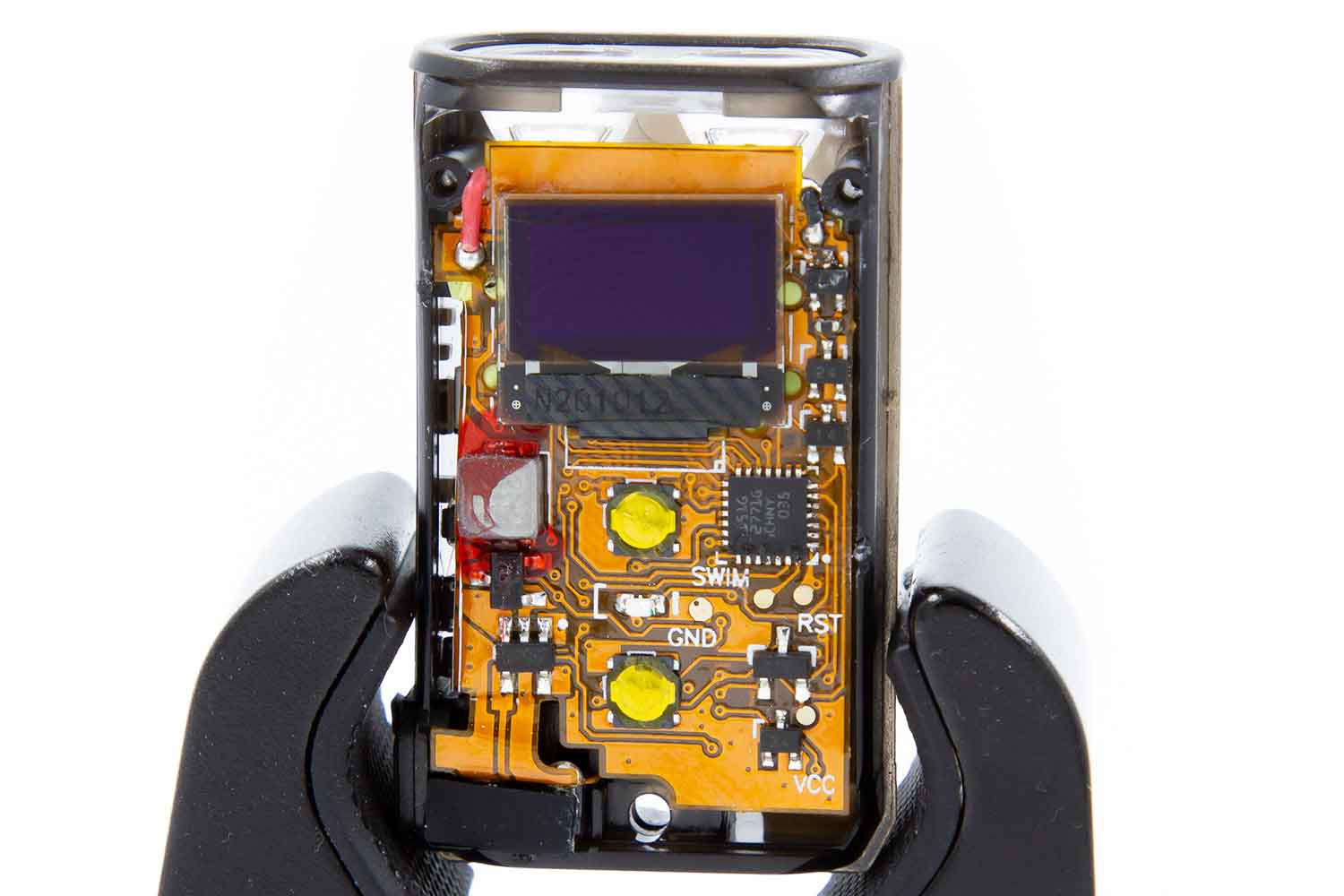
Nitecore Tini 2 titanium & stainless steel performance test
For my readings, I use the following:
Lux Meter: For lumen readings and runtimes, an Adafruit TSL2591 connected to a Raspberry Pi running Ubuntu, using RuTiTe by bmengineer in a custom sphere. A UNI-T UT383S is used for candela readings.
DMM: UNI-T UT139C and UNI-T UT210E – 16AWG wire is used directly into the 139C via some banana plugs, and 8AWG wire in a loop for the UNI-T. The DMM I use depends on how high the expected current will be – I use the 139C for <10A, and the 210E for >10A.
Lumen measurements (for each mode)
Note that due to the difficulty of obtaining current draw, and the irrelevance due to inbuilt battery, I’ve removed the usual “Amps at start” column from this chart.
| Mode | Specs | @turn on | 30 sec | 10 min |
|---|---|---|---|---|
| Moon | 1 | 1 lm | 1 lm | – |
| Low | 15 | 16 lm | 15 lm | – |
| Med | 65 | 76 lm | 75 lm | 73 lm |
| High | 200 | 196 lm | 192 lm | 182 lm |
| Turbo | 500 lm | 471 lm | 458 lm | 190 lm |
Runtime graph
In testing, the SS and Ti models have an almost identical runtime to the TINI2 I reviewed, and this could be down to something as simple as the temperature in my office when running them. As a result, overlaying the runtimes would be somewhat confusing with overlapping lines/colours.
What I’ve done is cleaned up the runtime chart from the TINI2 review, to make things obvious as to the runtimes in the top three modes.
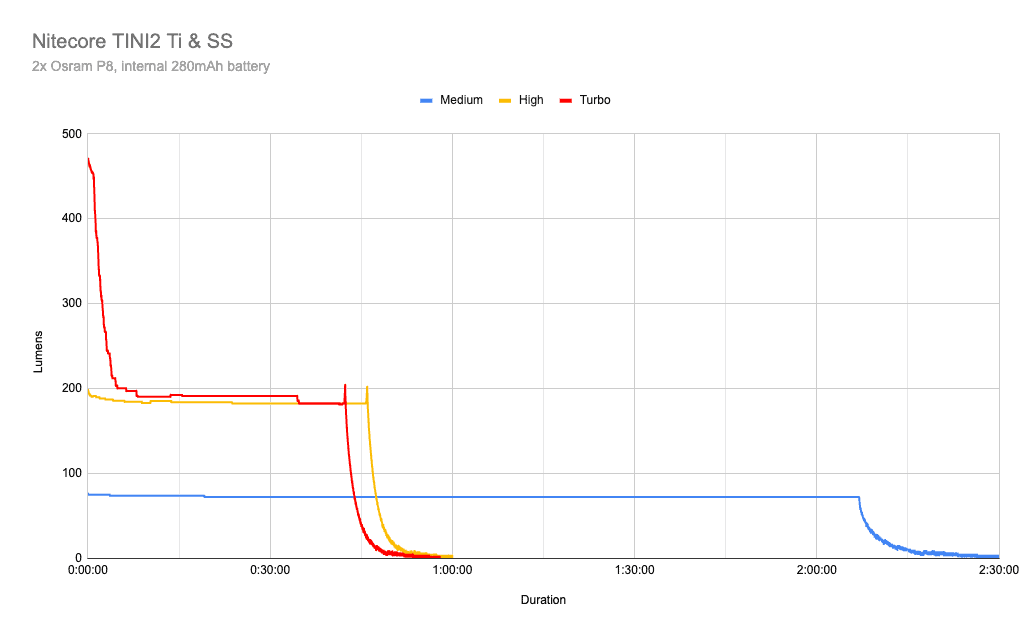
Throw numbers:
Readings were taken at 5 metres for Mid, High, and Turbo. Each mode is tested three times, waving the hotspot around the sensor gently, and recording the maximum lux value, and then an average is taken.
Taking a reading for Low and Ultralow would be somewhat pointless in my opinion, as they’re very low modes.
| Mode | Specs | Candela measured | Meters | Yards |
| Medium | 260 cd | 250 cd | 32 | 35 |
| High | 800 cd | 1,025 cd | 64 | 70 |
| Turbo | 2,000 cd | 2,100 cd | 92 | 100 |
At 5m, 1 lux is 25 candela – just to explain why they’re fairly round numbers.
Beamshots
Taken at 5m from garage door. Annoyingly a neighbour’s security light kept coming on, giving extra light behind it.
Shots taken at 0.3 sec, f6.3, ISO 1600.
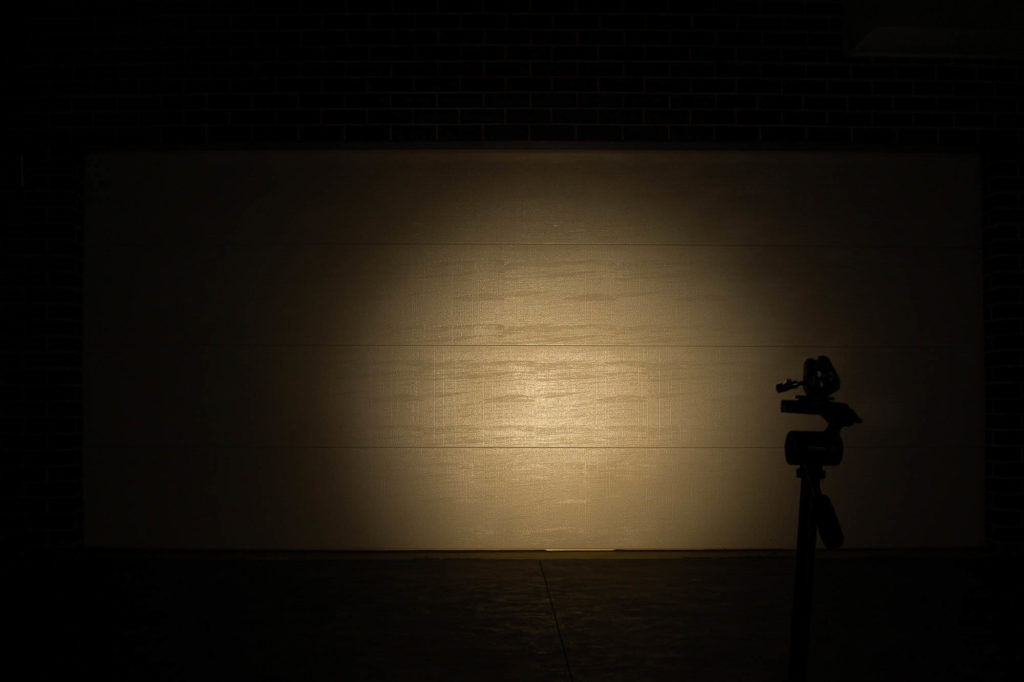
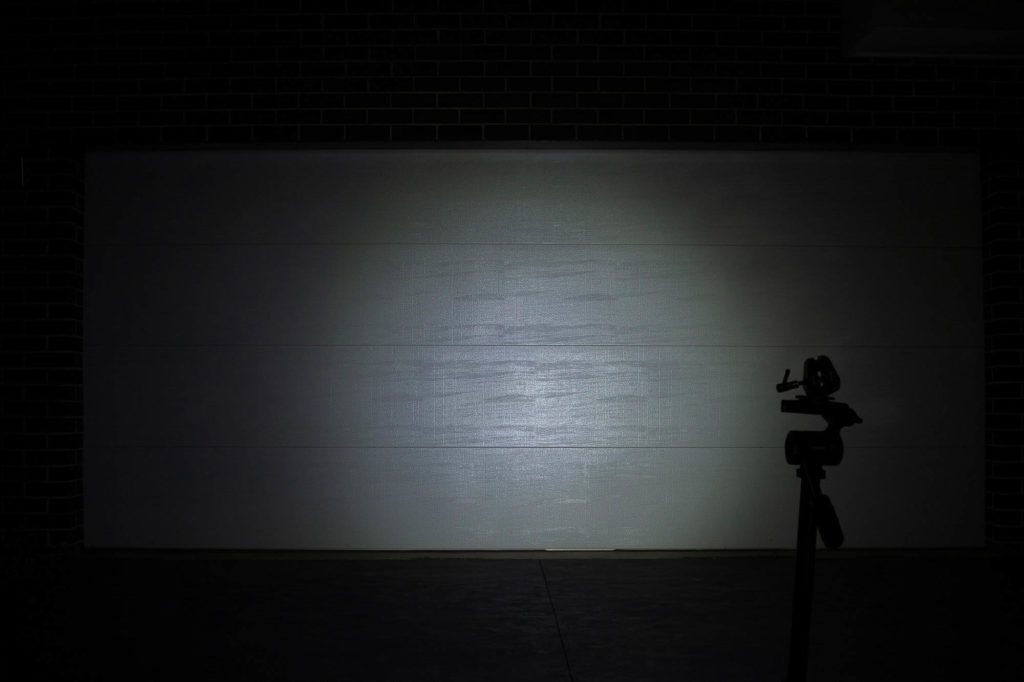
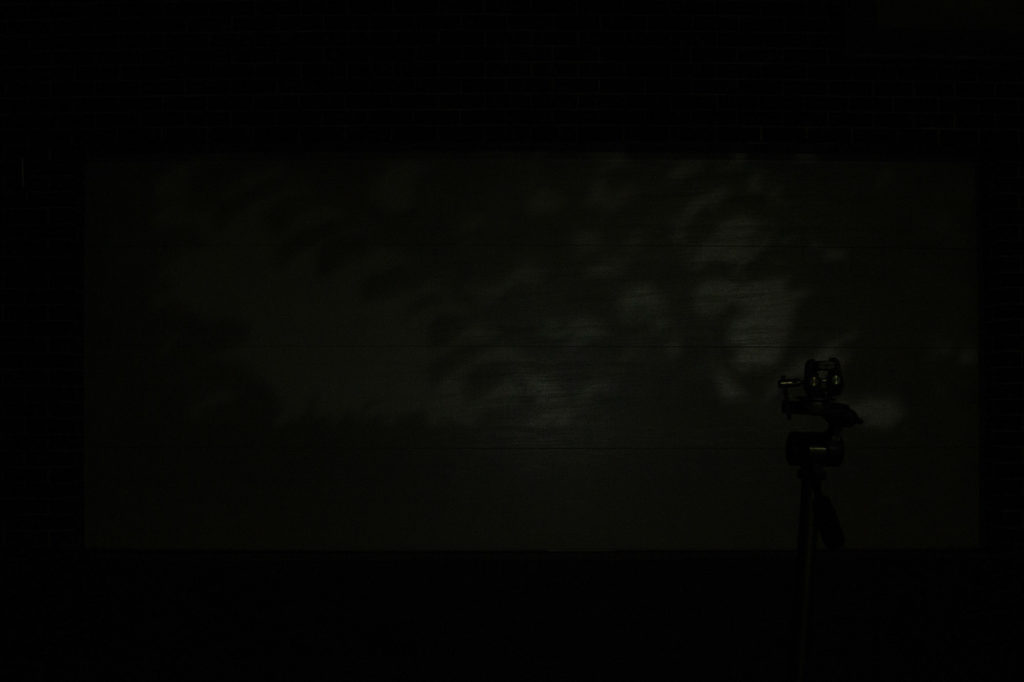
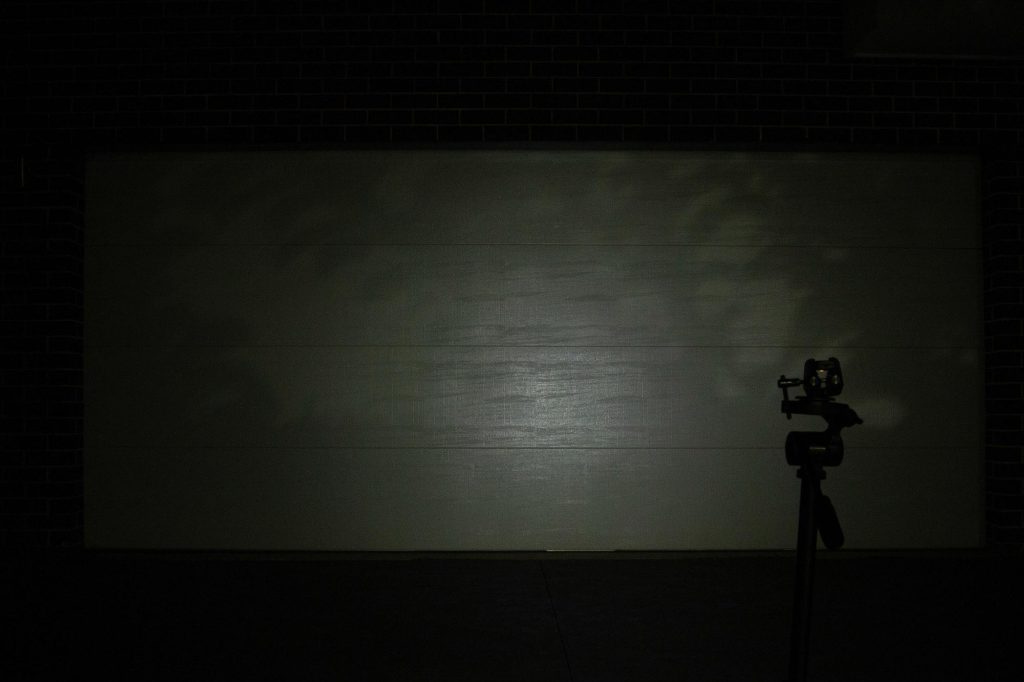
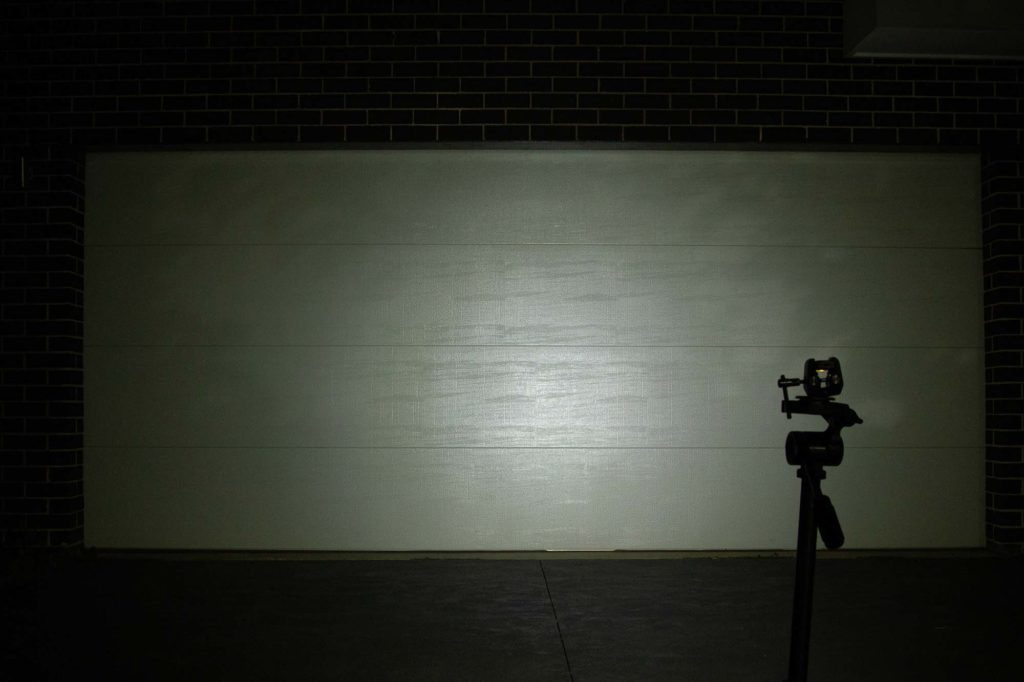
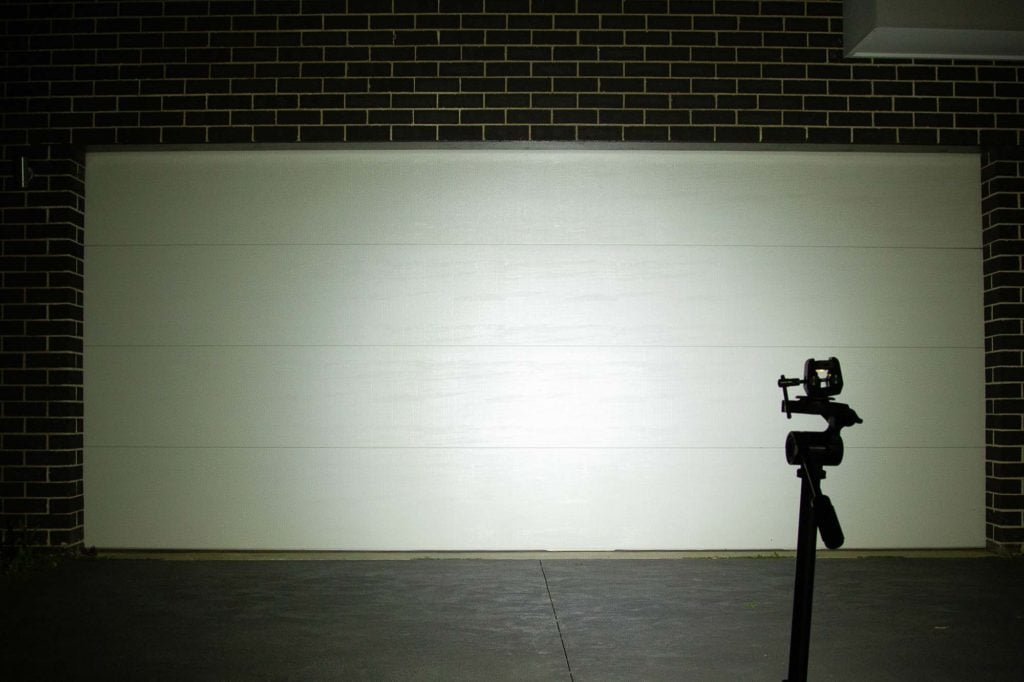
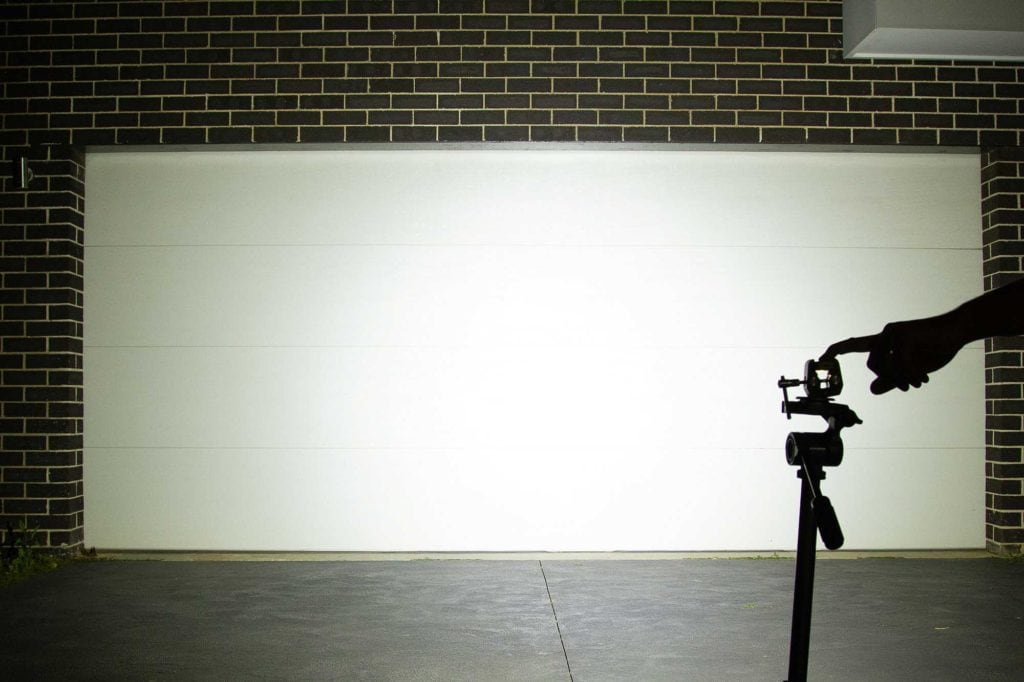
Disclaimer: This flashlight was sent to me for review at no cost by Nitecore. I have not been paid to review, nor have I been holding back on problems or defects.
Final Verdict
Pros
- Great UI
- USB-C charging is a breeze
- Good performance/size ratio
- Love the finishes!
Cons
- Small-ish battery
- Cool white emitters
Explanation on star ratings:
1: Avoid: my phone flashlight would be a better choice – 2: Poor: significant defect or issues; almost unusable – 3: Average: some defects or issues; but still usable 4: Good: recommended (minor issues) – 5: Great: highly recommended

4.5 stars: ★★★★⋆
I previously gave the TINI2 4.5 stars, and I definitely meant it – with the addition of the two new finishes, I don’t feel the score increases, as the things I saw as cons are still there, but it’s very nice to have options to suit your particular style. This is an evolution, not a revolution.
The TINI2 still lives on my car keys, but I think it’s going to be swapped out with one of these two.. I’m just not sure yet which one.
I mentioned the MSRP in my Nitecore TINI2 review, and the new finishes only seem to add $5USD to the price (according to nitecorestore.com), which is very reasonable in my opinion.
Again – 4.5 stars. Nitecore, please look into some super sexy emitters!
Nitecore Tini 2 Ti discount coupon code
Get 15% off by using discount code 15OFF on orders above $75. Below $75, use our unique coupon code 1Lumen to get 10% off.
1lumen selects and reviews products personally. We may earn affiliate commissions through our links, which help support our testing.